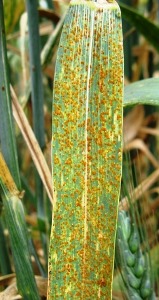Leaf rust of wheat
Compared to stripe and stem rust, leaf rust is potentially the least damaging in susceptible varieties, but in most seasons, conditions are conducive for this disease to develop. In Victoria, severe leaf rust infections can reduce grain yield by more than 20 per cent in susceptible varieties and can also reduce grain quality. Leaf rust is effectively controlled when resistant varieties are grown, but when susceptible varieties are grown fungicide protection with fungicides may also be required.
Recent detections of new pathotypes of leaf rust means that The detection of a new pathotype of leaf rust in Victoria during 2014 increased the importance of this disease, as many important cultivars have poor levels of resistance to leaf rust. are now more susceptible to this new pathotype than the older strains.

What to look for
Leaf rust is a relatively easy disease to diagnose as it forms orange-brown pustules that are raised above the leaf surface. These pustules can be rubbed off the leaf leaving an orange-brown mark on the finger.
The pustules scattered across the leaf surface are circular to oval in shape, and confined chiefly to the upper surface of the leaf. Later in the season, black teliospores develop on mature plants, usually on the under surface of the leaf or on the leaf sheath. These black spores are not of concern.
Disease cycle
Leaf rust is caused by the fungus Puccinia triticina.
Leaf rust, like other cereal rusts, requires a living host to survive from one season to the next. The most important host for rusts in Australia are susceptible volunteer wheat plants growing during the summer and autumn.
Rust cannot carry over from one season to the next on seed, stubble or in soil.
Wheat varieties susceptible to leaf rust enable inoculum levels to build up on volunteers during the summer and autumn. This can be a problem in seasons following wet summers that favour the growth of self-sown wheat. Plants that become heavily infected with rust in the autumn provide a source of rust for the new season's wheat crop. If these conditions are followed by a mild winter and a warm wet spring, then the chances of a leaf rust epidemic are high. Therefore, the chances of a rust epidemic are greatest following a wet summer.
In Australia, due to the absence of the alternate host, leaf rust reproduces asexually. This reduces the variability of the rusts in the field and therefore increases the likelihood that resistant varieties will be effective for a long period of time.
Rust spores are wind-blown and can be spread over large areas in a short time. The establishment of leaf rust epidemics within a crop is favoured by wet conditions and temperatures of in the range of 15-22°C.
Management
Resistant varieties
The best way to control manage leaf rust is to avoid susceptible varieties. When grow resistant varieties and when most wheat varieties are resistance long term control can be achieved.
However, leaf rust occasionally produces new races which are capable of attacking varieties that were resistant when they were first released. These new races occur when a chance mutation occurs in this asexually reproducing fungus. Widespread cultivation of resistant varieties minimises the levels of rust in the environment and reduces the occurrence of new races.
It is important that growers are aware of their varieties’ disease resistance to leaf rust. Variety resistance ratings are available in the Victorian Cereal Disease Guide and on the National Variety Trials (NVT) website. It is important to use a current disease guide as mutations occur in rust from time to time and resistant ratings are adjusted accordingly.
Cultural practices
Heavy grazing or the use of herbicides during autumn to remove self-sown susceptible wheat will reduce the amount of rust in following crops. However, if spring conditions are favourable for leaf rust development, then even small amounts of rust that survived the autumn can multiply to cause serious yield losses in the spring.
Seed treatments
There are seed treatments available which will suppress early infections of leaf rust. Seed treatments are important in susceptible varieties, especially if they are sown early or following a wet summer favouring growth of volunteers.
Foliar fungicides
There are a number of foliar fungicides registered for the control of leaf rust in wheat. Fungicides should not be regarded as a substitute for growing resistant varieties. They are more of a back up for when a new race of rust evolves and for use in regions where adequate resistance is not available.
A fungicide response is unlikely in resistant or moderately resistant varieties. The earlier in a season that a rust epidemic starts, then the greater the potential yield loss. Crops need to be monitored to detect rust early, as timing is critical for the effective control of rust diseases with fungicides.
Rust epidemics can be explosive, and once out of control, can be difficult to contain.
Like the other rusts it is important to apply fungicides early in the epidemic. If a severe epidemic develops early in the season in a susceptible variety, then it may be necessary to make two applications of fungicide.
Rust first appearing after ear emergence is less likely to have a significant impact on grain yield.
Further Information
- Grains, pulses and cereals
- Victorian Cereal Diseases Guide
- Decimal Growth Scales of Cereal
- Victorian Crop Sowing Guide
- Wallwork H (2000) Cereal Leaf and Stem Diseases. (Book) GRDC
For rust identification, send rusted plant samples in a paper envelope (do not use plastic wrapping) to:
Australian Cereal Rust Survey
Plant Breeding Institute
Private Bag 4011
Narellan NSW 2567
Contact
Dr Grant Hollaway
Dr Mark McLean
Cereal Pathologists – Horsham
03 5450 8301
Field Crops Pathology
Grains Innovation Park
110 Natimuk Rd
Horsham 3400
03 5450 8301
Or call the Customer Service Centre, 136 186
Acknowledgments
Grant Hollaway. Support by the Grains Research and Development Corporation is gratefully acknowledged.